The study of a novel high selectivity pyrenyl-based fluorescence probe with aggregation-induced emission characteristics for Fe3+ detection designed by a structure modulation strategy†
Abstract
The past decades have witnessed the feat of fluorescent probes for Fe3+ detection, where eliminating the interference by other metal ions plays a pivotal role in its detection by probes in complex environments. Herein, by taking advantage of the substituent effects, the electron-withdrawing group (EWG) –CF3 and electron-donating group (EDG) –CH3 were introduced to 2-(1-pyrenyl)pyridine (pypyr) to prepare two turn-off fluorescence probes, 5-trifluoromethyl-2-(1-pyrenyl)pyridine (pypyr-CF3) and 5-methyl-2-(1-pyrenyl)pyridine (pypyr-CH3). Intriguingly, both probes displayed novel aggregation-induced emission (AIE) characteristics in MeCN/H2O mixtures and the size and morphology of the aggregated particles were studied via DLS and TEM. By the modulation strategy, pypyr-CF3 can detect Fe3+ in the presence of 29 different metal ions without interference. Comparatively, pypyr-CH3 experienced serious interference from other metal ions such as Hg2+ and Zr4+. Besides, pypyr-CF3 not only demonstrated a higher photoluminescence quantum yield (PLQY) of 65.25% and wider pH adaptability but is also capable of Fe3+ detection over a wide pH range of 2–11 with a short response time (5 seconds). A plausible quenching mechanism based on the inner filter effect has also been demonstrated. More importantly, the versatile applications of pypyr-CF3, such as the quantitative analysis of Fe3+ in actual water samples, anti-forgery ink, fingerprint identification, etc., further corroborate its superb capabilities. This study aims to lend concrete support to the design and selectivity modulation of probes.


 Please wait while we load your content...
Please wait while we load your content...